The Salisbury Doom
The conservation of The Last Judgement and other paintings at St Thomas’s, Salisbury
Peter Martindale
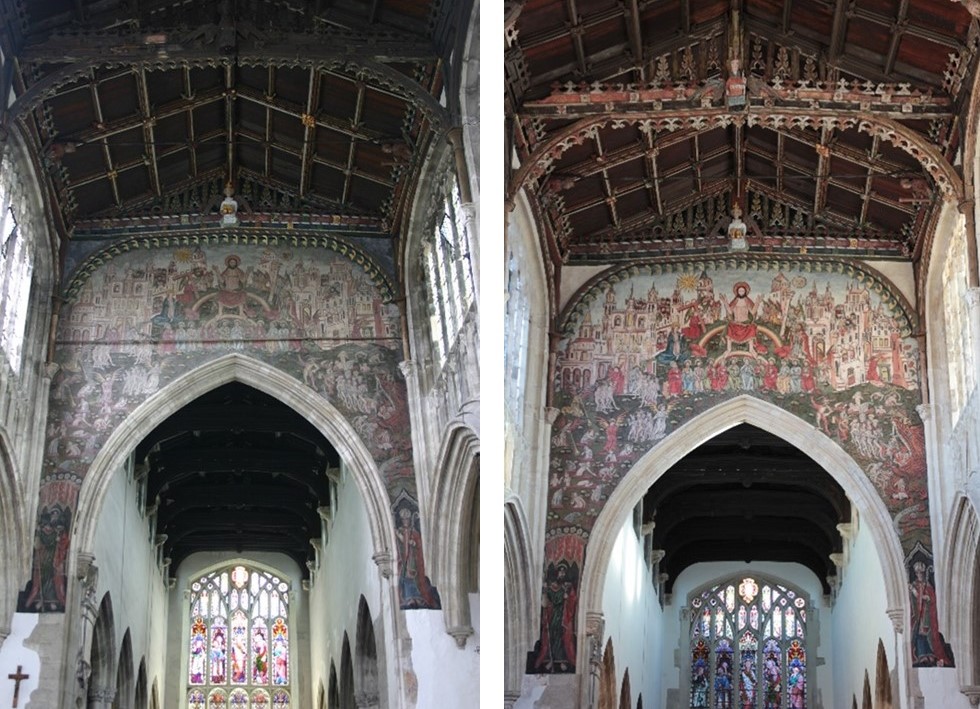
The east wall of the chancel and roof timbers, before and after conservation (All photos: Peter Martindale Conservation)
In the late summer and early autumn of 2019, the Parish of St Thomas’s, Salisbury, commissioned a programme of conservation, which included The Last Judgement or ‘Doom’ wall painting on the east wall of the nave, the walls of bays one and two of the nave (adjacent to The Last Judgement), and the painted timbers in the roof of bay two.
This substantial programme of conservation was just part of an ambitious programme of works, which included repairs to the stone flooring, repairs to the clerestory, the conservation and cleaning of two monuments, the introduction of new seating, and the installation of a new altar at the east end of the nave.
The principal item in this programme was The Last Judgement, which can be seen immediately on entering the main west entrance situated as it is on the east wall of the nave above the chancel arch. As some readers may already know, the wall painting we see is a late 19th century repaint of the medieval original, which is believed to date from around 1470. Some original medieval paint remains under the repainting, but it is uncertain how much.
The historical significance of this wall painting is briefly summarised by Dr Miriam Gill of Leicester University overleaf. After the Reformation in the 16th century, The Last Judgement was overpainted with limewash and it remained hidden until the 19th century when it was partially uncovered. In 1819 Elizabeth Wickens, from The Close in Salisbury, drew what was found and made notes on what she saw.
Subsequently the wall painting was overpainted once again with limewash. In 1881 the painting was uncovered for a second time, and overpainted by Clayton and Bell, which was one of the most prolific firms involved in the decoration of churches at that time. Uncovering, when carried out with proper care and attention, is a time-consuming and skilled process.
It is unlikely that the uncoverings carried out in the 19th century would have been executed with the care employed nowadays. As a result, it is almost certain that the painting was damaged to some degree.
Initial Surveys
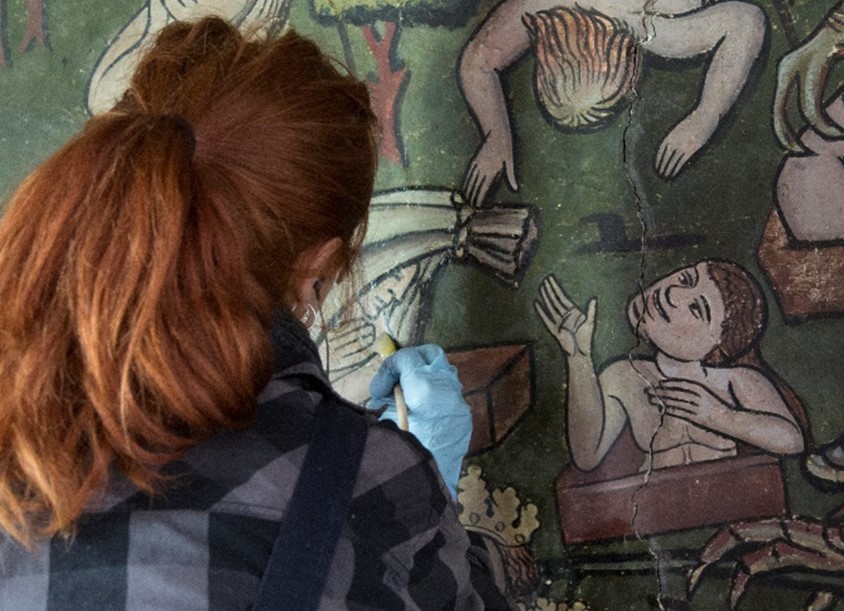
Joanna Pucci cleaning the surface with a chelating agent applied as a gel by brush. Residue from this operation, both dirt and chelating agent, was removed using cotton wool swabs dipped in de-ionised water.
For the first survey a cherry picker provided access to much of the wall painting, but not all. An important finding from that survey was the extent and degree of detached painted plaster. Another important finding came from the analysis of a number of paint samples, which were sent to a paint consultant, Catherine Hassall, for analysis.
Clayton and Bell had painted directly over the revealed medieval painting, and it is likely that they used the revealed painting as a ‘cartoon’ for their repainting. Analysis also indicated that the original painting had been varnished, a finding noted in subsequent investigations.
Not long after the survey I attended a symposium where a paper was given by Dr Gillian Walker from Reading University. Dr Walker and her Anglo/French team were using terahertz imaging to look under paint layers. Terahertz technology involves scanning surfaces at wavelengths of between 100 microns (10-6) and 1 millimetre (10-3).
Fortunately, Gillian and her team were available to look at The Last Judgement on the proviso that secure and stable access could be provided. Around the same time I also made contact with a colleague, Professor Adrian Heritage, as a result of hearing about work he was undertaking at the Houses of Parliament using infra-red photography.
Although Adrian was in post at Cologne University, he and two colleagues agreed to carry out imaging studies on The Last Judgement, so long as secure access could be provided. Following consultation with the parish, and architect (Antony Feltham-King), arrangements were made to erect a secure, fixed scaffolding so that all areas of the wall painting could be studied.
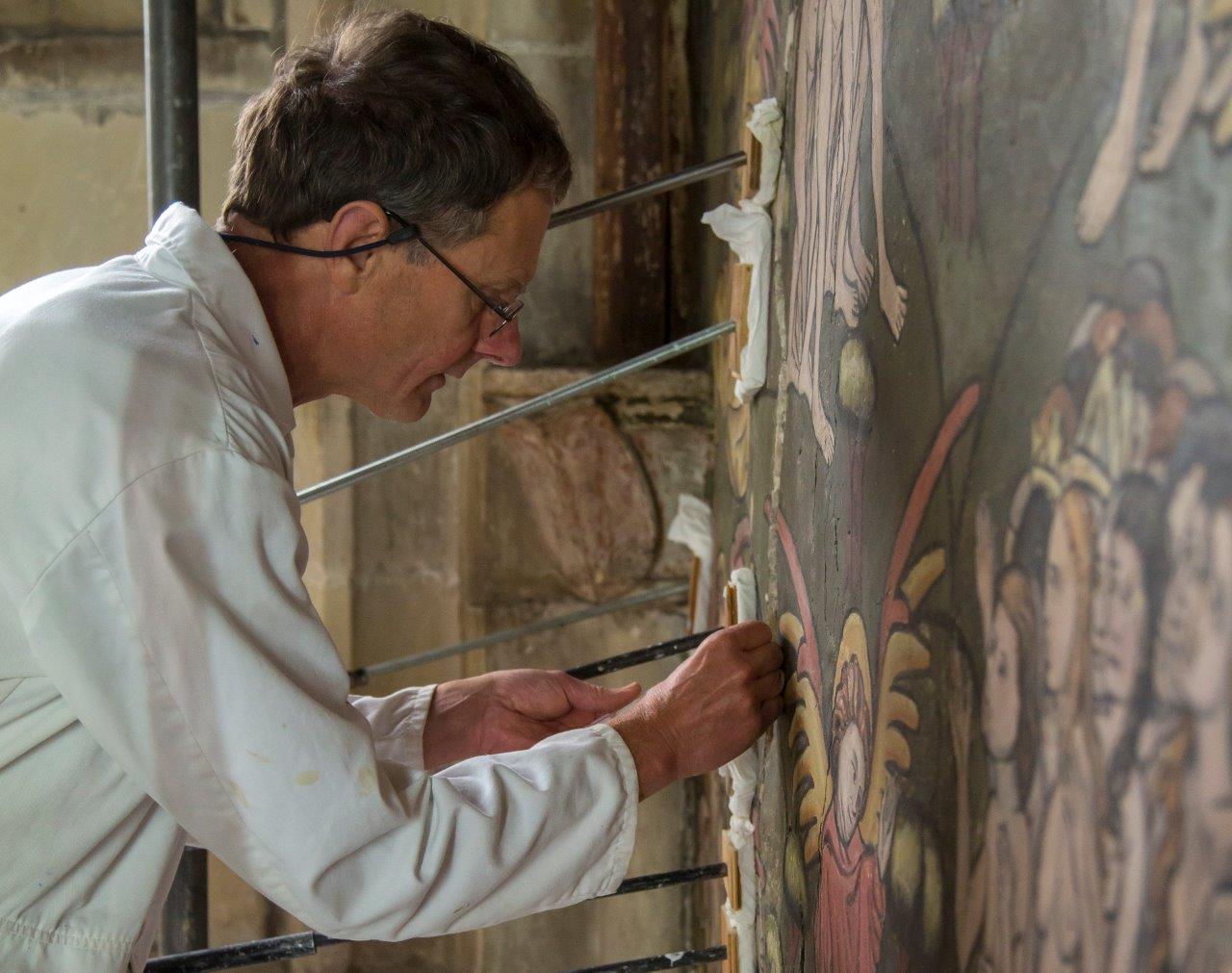
Peter Martindale consolidating areas of detached plaster: the metal bars which hold the pads in place are supported off the scaffolding.
The platform had to be particularly stable for the imaging techniques proposed. Each of Gillian’s terahertz scans took around 40 mins to complete. The slightest vibration would ruin the result, so we all had to vacate the scaffold. Adrian used an Osiris infra-red camera, which took images at a wavelength of 1700nm (1.7 microns) and was much less sensitive to vibration. Evidence of medieval paint under the 19th century repaint, was detected by both Gillian’s and Adrian’s teams; and the best results are shown here.
With a full scaffold the entire surface of the wall painting could be studied at close quarters. In terms of the future for the painting, the most significant finding from this and the previous survey was the extent of detached painted plaster. In places this was pronounced, and in some areas there was risk of imminent loss.
Treatment trials were carried out; these included securing detached painted plaster, securing paint flaking, and cleaning. Scaffold access enabled Antony Feltham-King and the structural engineer, Andrew Waring, to consider larger structural issues.
The Conservation Programme
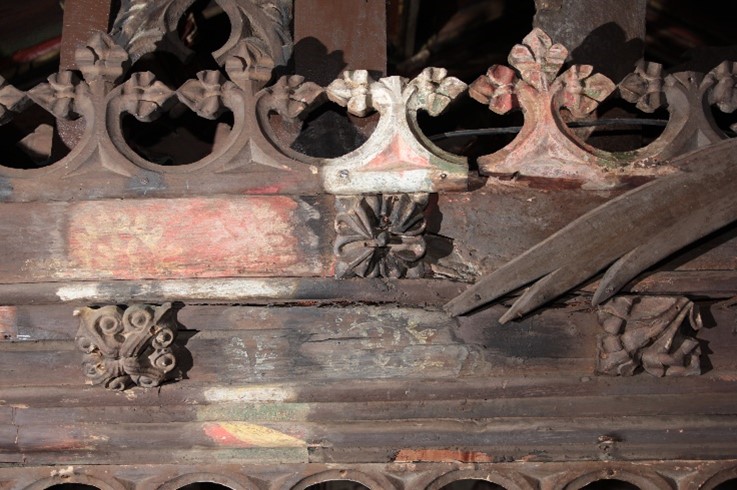
The process of medieval paint being revealed under later overpainted layers on a wooden tie beam.
In 2019 the programme of conservation largely focused on securing detached painted plaster, replacing earlier loose plaster repairs, and cleaning; with some time spent securing areas of paint flaking. Areas of detached painted plaster were secured by injecting either lime slurry or lime grout into voids behind the painted plaster.
Once the slurry or grout was introduced a springloaded press was positioned to hold the treated section of painted plaster in position while the slurry/grout cured. Cleaning was undertaken in three stages. Firstly, loosely adhering dirt and dust were removed using soft artist’s brushes, directing the unwanted dirt and dust into the nozzle of a vacuum cleaner.
This operation was also valuable because it meant the entire surface of the wall painting could be closely observed in a methodical manner. Instances of paint flaking were consolidated. For the second stage, more stubborn surface dirt was removed using small damp sponges.
The visual improvement from this alone was apparent. The final stage involved the use of a chelating agent applied as a gel by brush. Residue from this operation, both dirt and chelating agent, was removed using cotton wool swabs dipped in de-ionised water.
The improvement in the appearance of the wall painting from this stage was marked. Another factor which enhanced the appearance of the wall painting was the removal of an iron tie bar, set horizontally across the middle of the wall painting.
When the idea of removing the iron tie was first considered, it was decided not to in case this lead to structural damage. However, during the course of the work, loose cement mortar was removed where the tie bar pierced the south wall, revealing that the tie bar had rusted through and was no longer functioning as intended.
Following consultation with the architect and structural engineer permission was given to remove the tie bar. As a result of cleaning, traces of the medieval painting can be seen in the top third of the painting under the 19th century repaint. Analysis of paint samples from The Last Judgement, taken during treatment, showed that there is another paint layer below this one, indicating that there was at least one earlier medieval scheme.
As one moves down the painting, evidence of more than one overpainting becomes increasingly apparent, with the greatest amount of overpaint in the lowest third of the wall painting. Unexpected passages of medieval painting were found at the very bottom of the wall painting, and on the wall immediately below it.
More than one layer of medieval paint was identified and some of what we found remains on view; the rest has been painted out using reversible paint. It is worth taking binoculars when visiting St Thomas’s, so that you can see these passages clearly.
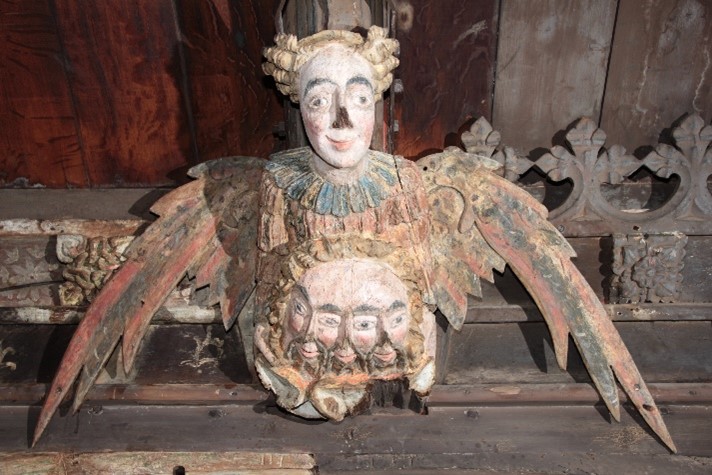
A carved and polychromed angel holding a tricephalous head: the polychromy is 18th century, with some traces of underlying medieval paint.
The second component of the programme of conservation concerned the walls of bays one and two of the nave. This aspect proved to be more rewarding than anticipated because the result achieved from cleaning the ashlar was much better than originally hoped for, and some particularly interesting findings were made.
The most significant of these was that the shields on the capitals at clerestory level, six on each side of the nave, are painted with merchant’s marks. When the wall painting was created, in the late middle-ages, Salisbury was the sixth largest city in England, and St Thomas’s attracted financial support from wealthy merchants. The marks are a permanent reminder of those who invested in the building of the church.
Another discovery was medieval paint on the engaged columns above the capitals. It is possible that the paint, a field of black with a bright border in red and yellow, formed the backdrop to sculptures set atop the capitals. Today there are wooden posts in that location.
The third component of the conservation programme was removing layers of plain overpaint from the colourful roof timbers in bay two of the nave. It also involved removing surface dirt and dust from the polychromed timbers in bay one, which had been treated by Herbert Read in 1993.
These timbers had been decorated in the late 15th century. In 1769 they were repainted, in most areas decoratively as originally, but in other areas with plain paint. Subsequent to this, three layers of oil-based paint were applied, the first of these is likely to date from the 19th century.
Most of the revealed polychromy that we can see dates from 1769, and lies over original medieval polychromy; but some original medieval painting was revealed. Plain overpaint was removed from two of the carved and painted angels in bay two, one of which incorporates a fascinating tricephalous (three heads in one) image.
This revealed decoration dating to the 1769 repainting, with occasional traces of original polychromy. Although eye catching today, the original scheme would have been even more striking, glistening with gilding. Removal of overpaint from the tie beam revealed lively medieval decoration, which had not been repainted in 1769.
Looking Back
In spite of what happened to it in the 19th century, The Last Judgement remains very valuable both nationally and internationally.
This depiction, although repainted, provides us with an excellent example of what a complete medieval last judgement wall painting looked like.
The work described here was undertaken by a team of conservators. I was the lead conservator and main contractor.
My team included three principal conservators – Joanna Pucci, Jason Battle and Alvar Mailan; with Robert Read, Roger Stephens and Howard Chivers.
Without the determined effort of the Parish of St Thomas’s, Salisbury, this challenging and ultimately rewarding project would not have come to fruition.
I am very grateful to the parish for commissioning this work, and I especially thank Meryl Brown, Nick Beard, Peter Heier, John Bruce-Ball and the Reverend Kelvin Inglis. The parish team were welcoming and highly interested in the work; something we appreciated very much. In particular we enjoyed the wonderful selection of cakes every Tuesday morning!
Recommended Reading
For more information about the conservation work, a talk given by Peter Martindale to the Traditional Paint Forum in 2020 is available here: bc-url.com/st-thomas-salisbury
For more information on the history of Doom paintings, see: ‘The Doom in Holy Trinity Church and wall-painting in medieval Coventry’, Coventry: Medieval Art, Architecture and Archaeology in the City and its Vicinity, L Monckton and RK Morris (eds), BAA 2011, 206–222.
‘Medieval wall painting of the Doom, Holy Trinity Church, Coventry’, The History of British Art, 600–1600, T Ayers (ed), Tate 2008, 200–2.
‘Significance of the site and historical setting for the “Doom” painting’, Conservation of the ‘Doom’ Wall Painting, Holy Trinity, Coventry, abstract of papers presented at the Symposium in memory of Anna C Hulbert, 2005, 11–13.



